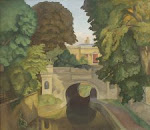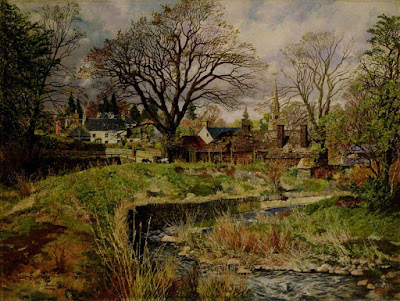Now, above us, we have cherry, plum, pear, and magnolia blossoms. At our shoulders we have camellia blooms. And at our feet we have -- joining the previously-arrived crocuses -- daffodils, hyacinths, and a few early tulips. This is only a partial inventory. As for the trees: they are still biding their time, although their branches are tipped with green leaf-buds, at the ready.
Pear Blossoms by the Eastern Palisade
Pear blossoms pale white, willows deep green --
when willow fluff scatters, falling blossoms will fill the town.
Snowy boughs by the eastern palisade set me pondering --
in a lifetime how many springs do we see?
Su Tung-p'o (1036-1101) (translated by Burton Watson), in Burton Watson, Selected Poems of Su Tung-p'o (Copper Canyon Press 1994), page 68.
"Snowy boughs." The confusion of spring fruit tree blossoms with snow-filled branches is a venerable poetic conceit, isn't it?
For instance:
The Cherry Trees
Under pure skies of April blue I stood,
Where, in wild beauty, cherries were in blow;
And, as sweet fancy willed, see there I could
Boughs thick with blossom, or inch-deep in snow.
Walter de la Mare, Memory and Other Poems (Constable 1938). De la Mare uses the word "blow" (line 2) in a sense that is now, alas, considered archaic: "to blossom; to bloom."
This also comes to mind:
Nailsworth Hill
The Moon, that peeped as she came up,
Is clear on top, with all her light;
She rests her chin on Nailsworth Hill,
And, where she looks, the World is white.
White with her light -- or is it Frost,
Or is it Snow her eyes have seen;
Or is it Cherry blossom there,
Where no such trees have ever been?
W. H. Davies, The Loneliest Mountain and Other Poems (Jonathan Cape 1939).
James McIntosh Patrick (1907-1998), "Glamis Village in April"
The blossom-snow confusion leads many of us to return to a poem we visit each spring. Mere habit, perhaps. Or ritual. But, consider this: we are not who we were last spring, are we? We have no way of knowing how the poem will make us feel this spring. There is something to be said for habit and ritual in the midst of a feckless world.
Loveliest of trees, the cherry now
Is hung with bloom along the bough,
And stands about the woodland ride
Wearing white for Eastertide.
Now, of my threescore years and ten,
Twenty will not come again,
And take from seventy years a score,
It only leaves me fifty more.
And since to look at things in bloom
Fifty springs are little room,
About the woodlands I will go
To see the cherry hung with snow.
A. E. Housman, A Shropshire Lad, Poem II (Kegan Paul 1896).
"To see the cherry hung with snow." For some of us, this line is the embodiment of spring. The novelist J. L. Carr (A Month in the Country) served as the headmaster of a primary school in Kettering, Northamptonshire, for fifteen years. Through the streets of Kettering, "under the cherry trees, Carr would march his entire school in the spring, all chanting, 'Loveliest of trees . . .'" (Byron Rogers, The Last Englishman: The Life of J. L. Carr (Aurum Press 2003), page 153.)
James McIntosh Patrick, "A City Garden" (1940)
So, dear readers, here we are again: at the intersection of Beauty and Evanescence, in the land of bittersweet wistfulness and wistful bittersweetness. Also known as Life.
"In a lifetime how many springs do we see?" Su Tung-p'o wrote that line in 1077. Eight centuries later, in 1895, A. E. Housman wrote: "And since to look at things in bloom/Fifty springs are little room,/About the woodlands I will go/To see the cherry hung with snow." The good poets, in all times and in all places, know what is humanly important, know where our attention should be directed. Human nature was the same in China in 1077 and in England in 1895. And wherever you are at this moment.
Spring Night
Spring night -- one hour worth a thousand gold coins;
clear scent of flowers, shadowy moon.
Songs and flutes upstairs -- threads of sound;
in the garden, a swing, where night is deep and still.
Su Tung-p'o (translated by Burton Watson), in Burton Watson, Selected Poems of Su Tung-P'o, page 19.
James McIntosh Patrick, "Glamis Village" (1939)






10 comments:
I try to read a poem every morning before the news and emails impinge and then record the title in my daily journal. You have given me a bounty of poems. I also love the paintings on this post. Sigh. 75 springs for me now and they never get routine. Here in the southern coastal U.S., dogwood blooms horizontally, seeming to float without benefit of branches. Wisteria, azaleas and spirea explode into being. Thank you so much for this wistful, beautiful post. As always.
An altered look about the hills—
A Tyrian light the village fills—
A wider sunrise in the morn—
A deeper twilight on the lawn—
A print of a vermillion foot—
A purple finger on the slope—
A flippant fly upon the pane—
A spider at his trade again—
An added strut in Chanticleer—
A flower expected everywhere—
An axe shrill singing in the woods—
Fern odors on untravelled roads—
All this and more I cannot tell—
A furtive look you know as well—
And Nicodemus’ Mystery
Receives its annual reply!
--Emily Dickinson
Spring once again come to New England, says Dickinson. Why do we seek miracles in the skies, the sweet torment of hidden mysteries, when yearly we behold the miracle and mystery of spring. If we, as did Nicodemus wondered of Christ, wonder how one can be born again, could not the blossom at my window reveal an answer a host of metaphysicians couldn't fish from a mud puddle?
Oh my, how this post resonated with me. I will copy the Sun Tung-p'o poems in my journal, certain of enjoying them time after time. Many of the poems that you have shared have found their way there. Thank you so much.
The term "blow" interests me too. I love those words that have gone their way and been lost, at least to too many. The shadblow bush comes to mind. I believe it may also be called the serviceberry. The woods in our mountains, small as they are here in Pennsylvania, shine with them. They blossom, of course, when the shad run. Another spring rite that many don't know about these days. Wood anemone, hepaticas, bloodroot, dutchman's britches, and trout lilies - rarer each spring. "...in a lifetime how many springs do we see?" Indeed.
Mary
Nikki: Thank you very much for your kind words about the post. I read a poem every morning as well. It is a fine way to begin the day.
"Sigh." I had a similar feeling when I read "Pear Blossoms by the Eastern Palisade" this year: "In a lifetime how many springs do we see?" I felt that I had wasted a great many of them. I also thought that, in Burton Watson's translation into English, the line can have two meanings. "See" can simply mean "live through," or "experience." But it can also mean "see with attention and awareness", not simply live through. But perhaps I am reading too much into it. (I don't know whether the original Chinese carries this potential ambiguity.) In any case, I again felt that I had missed the boat a number of times. I am happy to hear you say that "they never get routine" for you.
Thank you for visiting again, and for sharing your thoughts.
Lovely, Stephen. We may never meet, but I always enjoy marking the passing of the seasons through your blog.
Spring arrived with a few surprises here on the upper edge of southern Maryland. We've had four snakes in the yard, two of which needed rescuing from the atrocious landscape netting the previous owners of our home left behind. (We suspect the snakes reside part-time in our basement.) We've had a giant pileated woodpecker pounding on our window panes every morning for a week. And recently a mother fox with only three functional legs carefully move her pups, one by one, to higher ground when two days of rain flooded her den. We relocated just two miles down the road, and all of the plants and animals may be the same, but they're showing themselves in different proportions, giving this spring a whole new character. This spring is exactly like my last four--but then not a bit like any of them.
Anonymous: Another lovely and evocative poem by Dickinson: thank you very much for sharing it, together with your own thoughts. Spring's "annual reply" to the mystery of rebirth brings to mind the second stanza of Larkin's "The Trees" (which has appeared here on more than one occasion): "Is it that they are born again/And we grow old? No, they die too,/Their yearly trick of looking new/Is written down in rings of grain." Larkin can never resist reminding us of our mortality. (A good thing, in my opinion.) Still, he ends "The Trees" with this stanza: "Yet still the unresting castles thresh/In fullgrown thickness every May./Last year is dead, they seem to say,/Begin afresh, afresh, afresh." Perhaps he and Dickinson are not far apart.
Thank you again.
Mary: Su Tung-p'o's poems (and Burton Watson's translations) are lovely, aren't they? I have grown increasingly fond of his poetry over the years. One often first comes to Chinese poetry through the better-known T'ang Dynasty poets (Li Po, Tu Fu, Wang Wei, Po Chu-i), but there are a number of fine poets from the later Sung period as well (as I'm sure you know), and Su Tung-p'o is my favorite.
Thank you for introducing me to the "shadblow bush," which is new to me. I found some images on the internet: beautiful. The combination of "shad" and "blow" is indeed interesting. I think I first encountered "blow" in the sense of "to bloom, to blossom" in a poem by Christina Rossetti. I believe I have seen it also in a poem (or poems) by Housman. It was still quite prevalent in the the 19th century. De la Mare was never shy about using such "archaic" words in the 20th century.
As always, it is a pleasure to hear from you. I hope you are having a wonderful spring. Thank you very much for stopping by.
Jeff: It's good to hear from you again. Thank you for the kind words -- that's very nice of you to say. I'm grateful for your long-term presence here through all of these springs.
Thank you for the spring report from your neck of the woods. You certainly have a much livelier and wilder neighborhood than I do. Foxes! The mother moving her cubs must have been a wonderful thing to see. The World is always presenting us with lovely surprises, isn't it? It keeps us awake and alive. (Which vaguely sounds like lyrics from a song -- perhaps I'm being subconsciously influenced by the post titles from Quid Plura!)
As ever, thank you very much for visiting. Please return soon.
I enjoyed this post so much! I hadn't known the other poems (in addition to Housman's) that play with the blossom/snow confusion; thank you for introducing them to me. And I love your phrase "at the intersection of Beauty and Evanescence." I hope I'm not overstepping if I link to a piece I wrote recently about spring ephemeral wildflowers, which bloom at that intersection: https://www.3quarksdaily.com/3quarksdaily/2019/04/blossom-by-blossom-the-spring-begins.html
Mary: Please accept my apologies for the delay in responding to your comment. Thank you very much for your kind words about the post -- I'm pleased you liked it. I'm quite fond of all those poems.
And thank you as well for the link to your piece at 3 Quarks Daily. (You are not "overstepping" at all by sharing it.) I envy you your knowledge of the spring wildflowers. I am ignorant enough to have never heard the term "spring ephemerals" before -- lovely. I enjoyed your discussion of the word "ephemeral." As I was reading it, Yeats' poem "Ephemera" came to mind: ". . . and the yellow leaves/Fell like faint meteors in the gloom, and once/A rabbit old and lame limped down the path." (After more than 40 years, I've still not lost my fondness for Yeats' 1890s Celtic Twilight period.)
Thank you for visiting again, and for sharing "Blossom by Blossom the Spring Begins."
Post a Comment